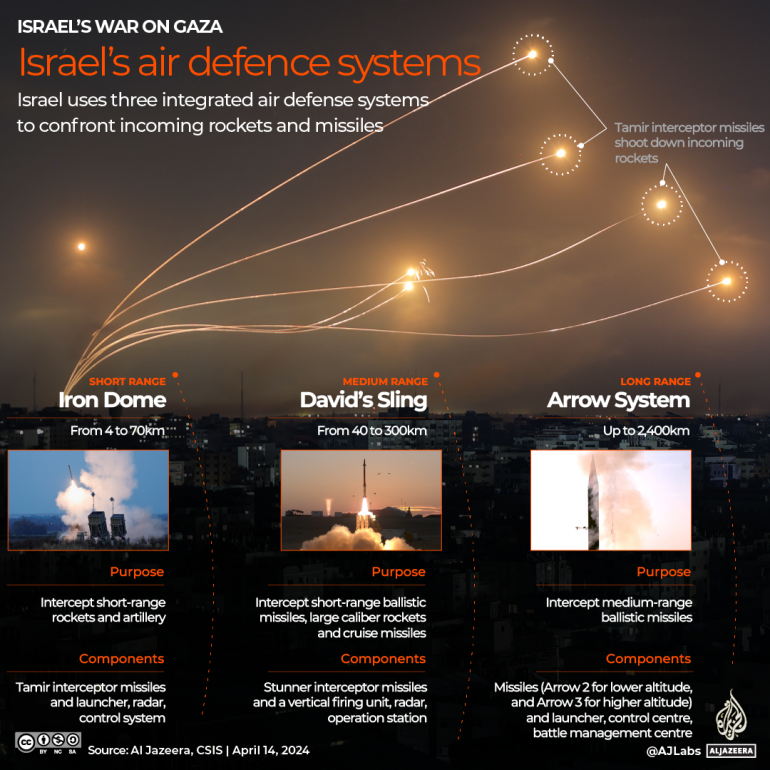Mapping 8,500 cross-border attacks between Israel and Lebanon
Hezbollah warns of a ripple effect across the Mediterranean Sea if Israel widens its conflict against Lebanon.

Tensions between Israel and the Lebanese group Hezbollah are escalating as Israel’s war on Gaza has entered its 11th month.
Since October 8, when Hezbollah began launching attacks on Israel in solidarity with the Palestinian people, Israel has attacked it nearly four times as much, with more than 7,000 attacks along the 120km (75-mile) border.
Keep reading
list of 4 itemsIsrael’s intensifying attacks on Gaza schools
Mapping far-right riots in the UK
Where are the world’s millionaires and how is wealth divided globally?
Hezbollah, which was formed in 1982 to fight Israel’s invasion and occupation of southern Lebanon, says it will stop attacking Israel if its assault on Gaza stops.
In 2006, the group fought a 34-day war widely regarded as a strategic and military failure for Israel, and its leader Hassan Nasrallah says Hezbollah does not seek an expanded war now but is prepared, backed by allies, to match Israel’s aggression.
Some Israeli leaders have pledged to remove Hezbollah from southern Lebanon, even by force.
The attacks
According to the Armed Conflict Location and Event Data Project, Israel, Hezbollah and other armed groups in Lebanon exchanged at least 8,533 attacks across the border from October 7 to July 31.
Israel conducted about 82 percent of these attacks, totalling 7,033 incidents, killing at least 601 people in Lebanon.
Hezbollah and other armed groups were responsible for 1,500 attacks that killed at least 23 Israelis.

In addition to Hezbollah – which bore the brunt of the hostilities – other notable forces involved in attacks against Israel include the Lebanese al-Fajr Forces and Amal Movement as well as Hamas’s Qassam Brigades and Palestinian Islamic Jihad’s al-Quds Brigades, both armed wings of the Palestinian groups that maintain a presence in Lebanon.

Israel has attacked these locations in southern Lebanon the most:
- Aita al-Shaab – 338 attacks
- Naqoura – 268 attacks
- Hula – 265 attacks
- Kfarchouba – 261 attacks
- Kfar Kila – 252 attacks
Groups from Lebanon attacked these locations in northern Israel the most:
- Kiryat Shmona – 150 attacks
- Margaliyot – 99 attacks
- Metula – 87 attacks
- Shtula – 73 attacks
- Manara – 77 attacks
Israel’s arsenal
Israel holds the most advanced missiles in the Middle East, many produced domestically, but most of its precision-guided missiles are from the United States.
According to the Center for Strategic and International Studies (CSIS), much of Israel’s capabilities are short-range tactical systems, including the Popeye, Extra and Gabriel missiles. Among its long-range missiles are Jericho 2 and Jericho 3 ballistic missiles with ranges of 1,500km to 3,500km (930 to 2,175 miles) and 4,800km to 6,500km (3,000 to 4,000 miles), respectively.
Also, despite not officially acknowledging it, Israel is believed to possess at least 90 nuclear weapons.

To confront incoming rockets and missiles, Israel uses three integrated air defence systems: the Iron Dome (short-range), David’s Sling (medium-range) and Arrow (long-range).
The Iron Dome was originally billed as providing city-sized coverage against rockets with ranges of 4km to 70km (2.5 to 43 miles), but experts said this has been expanded.
David’s Sling, produced by Israeli weapons giant Rafael, can intercept rockets and missiles with a range of 40km to 300km (25 to 186 miles). The Arrow series, led by the Arrow 3 interceptor, has an estimated fly-out range of up to 2,400km (1,491 miles).

Hezbollah’s arsenal
Hezbollah is considered to be one of the world’s most heavily armed nonstate actors with a rocket arsenal estimated to contain 130,000 pieces, according to the CSIS.
On October 19, Israel’s Institute for National Security Research published estimates of Hezbollah’s arsenal of missiles and drones. Hezbollah, it said, had 40,000 Grad-type missiles with a short range of 15km to 20km (9 to 12 miles).
A step up are 80,000 longer-range missiles, including the Fajr 3 and Fajr 5 ballistic missiles, with a range of 100km (62 miles).
Finally, there are about 30,000 Zelzal or Fateh-110 missiles with a range of 200km to 300km (124 to 186 miles) – the longest-range weapons in Hezbollah’s inventory, capable of reaching southern Israel.
